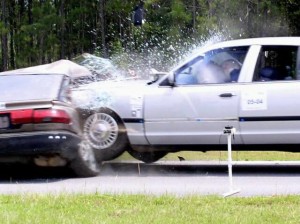There are many factors affecting whiplash injuries and the extent that they contribute to the severity of a whiplash injury. such as the direction of impact, the speed of impact, the size of the vehicles involved. your headrest position. and your posture at impact, your physical condition, your awareness of the impending collision, as well as your age
and sex.
Direction of Impact
The direction in which your vehicle is struck can have a tremendous impact on the type and severity of your injuries.
Rear-End Collisions
 By far, rear-end injuries can be the most severe. This is due to the fact that during the initial phase of the collision, the torso is held in place by the seat back. but the head is allowed to move freely, causing all of the energy of the accident to be transferred into the neck. The severity ofthe compression force
By far, rear-end injuries can be the most severe. This is due to the fact that during the initial phase of the collision, the torso is held in place by the seat back. but the head is allowed to move freely, causing all of the energy of the accident to be transferred into the neck. The severity ofthe compression force
in the neck causes the formation of an abnormal S-shaped curve to form, injuring the disc and tissues in the C5-C6 region (lower neck). In more severe cases, the nerve roots can be pinched and bruised, causing pain, numbness or tingling to be felt down one or both of the arms.
Substantial sprains and strains of the delicate muscles, ligaments and other connective tissues of the neck are very common, even in low-speed collisions.
Front-End Collisions
 Although front-end collisions tend to result in fewer severe injuries, front-end collisions will cause the occupant to get pushed forward violently. The chest and ribs can impact the steering wheel, causing a bruised rib cage and sometimes fractures.
Although front-end collisions tend to result in fewer severe injuries, front-end collisions will cause the occupant to get pushed forward violently. The chest and ribs can impact the steering wheel, causing a bruised rib cage and sometimes fractures.
And while it is true that air bags save lives, they can also cause broken noses and bruised ribs, and occasionally, tearing of the ligaments that hold the ribs together. Air bags deploy at speeds ranging from 165-210 mph! Therefore always keep your hands and arms away from the airbag area of your steering wheel.
Shoulder harnesses can also add to the injuries to the left shoulder and neck, in severe cases resulting in separated shoulder or damage to the brachial plexus in the neck. The hands and wrists holding the steering wheel can get suddenly hyperextended or hyperflexed, leading to carpal tunnel syndrome, and knees can be injured by impacting the dashboard.
Side-impact Collisions
 As odd as it may seem, side impact collisions tend to cause less severe whiplash injuries than front-end and rear-end collisions. The reason is that when the impact occurs, the torso is less restrained so less of the energy of the collision is transferred to the neck.
As odd as it may seem, side impact collisions tend to cause less severe whiplash injuries than front-end and rear-end collisions. The reason is that when the impact occurs, the torso is less restrained so less of the energy of the collision is transferred to the neck.
However, even though the risk of whiplash injury to the neck is reduced somewhat in side-impact collisions, there is a dramatic increase in injuries to the shoulder, rib cage and hip on the side of the collision.
Speed of Impact
It was once thought that the degree of injury was in direct proportion to the speed of the vehicles at the time of the collision. While there is some truth to this, numerous studies have found that collisions occurring at very slow speeds – even five to ten miles per hour – led to considerable whiplash injuries.
This occurs because at these slow speeds there is not enough energy to deform the metal of the automobiles and most of the energy is passed through the vehicle’s frame and into your body.
Vehicle Size
During a collision, the larger the striking vehicle is compared to the vehicle being struck, the greater the amount energy is transferred to the struck vehicle, and the more severe the injuries are to those inside. Even when the vehicles are the same size, an eight mile per hour collision produces an accelerating force on the car twice that of gravity, or 2-G, and a 5-G acceleration of the head. This can be interpreted as nearly 50.000 pounds of force in 2/10ths of a second!
Headrest Position
In order for the headrest to be effective, it must be about two inches from the head and high enough so that the back of your head can comfortably rest on it. Too often, people have their head restraint positioned too low. If it is too low, it can make an injury much worse by acting as a fulcrum over which the neck is forced to extend even further than it would have without the headrest at all.
Posture
 The position of the head at impact is critical to the degree of injury sustained. When turned to the side, for instance, the head can only bend forward about half as far as if it were in a front-facing position. Hence, all the force of the collision will be localized to one side of the spine, substantially increasing the severity of injuries.
The position of the head at impact is critical to the degree of injury sustained. When turned to the side, for instance, the head can only bend forward about half as far as if it were in a front-facing position. Hence, all the force of the collision will be localized to one side of the spine, substantially increasing the severity of injuries.
People who are struck from behind while they are talking to the person next to them or changing the radio station are much more likely to suffer a severe injury to the cervical spine than those who are sitting up straight and facing front.
Physical Condition
The better conditioned the body is in general, the more efficient the stabilization response will be and the more force the muscles, ligaments and other tissues can absorb without injury. Anyone who has watched a football game and witnessed the kind of collisions the players endure every Sunday has seen
how much of a role physical condition plays in whether injury occurs. Imagine if the average office worker were to be hit in the chest by a 365 pound muscle-bound monster running at full speed!
Awareness
Perhaps the most important factor that affects the efficacy of the stabilization response in relation to whiplash is awareness of the impending impact. People who can see an accident coming and brace themselves reduce their risk of injury considerably. Some studies have shown that passengers are more likely to sustain greater whiplash injury than the driver, as the driver is more likely to be aware of the impending collision.
Age
Age plays an important role because as the body becomes older, ligaments become less pliable, muscles weaker and less flexible, and the bones, joints and discs less able to absorb an impact without injury. Small children can also be easily injured as their skull is proportionately larger to their neck compared to adults. They also don’t have as much muscle mass to help stabilize their cervical spine (neck), making them more prone to injury.
Sex
Statistically, women are twice as likely to be injured in a motor vehicle collision and tend to be injured more seriously than men; mostly because they have smaller frames. have thinner and longer necks, and less supporting muscle mass.
Pre-existing Conditions
Any pre-existing condition, including past motor vehicle injuries, can have a negative effect on the severity of the new injuries, recovery time and prognosis. Many pre-existing conditions are “silent”, meaning they have no symptoms and can go undetected. Some of the more common pre-existing conditions are osteoporosis, osteoarthritis, spinal stenosis, and congenital fusion. These conditions complicate the recovery and prolong the need for continued treatment.
Recovery from Whiplash
With proper care, many mild whiplash injuries heal within four to nine months. However, more than 20 percent of those who suffer from whiplash injuries continue to suffer from pain, weakness or restricted movement two years after their accident.
Unfortunately, the vast majority of these people will continue to suffer from some level of disability or pain for many years after that, if not for the rest of their lives. Just as there are many different things that influence how severe a whiplash injury will be, there are numerous factors that have an impact on how completely an individual will recover, including:
- Symptoms persisting beyond six months
- Severity of ligament, disc, nerve, or joint injury
- Delay in initiating treatment
- Recurrent flare-ups of pain
- Age over 65
- Head restraint more than 2″ away from the head
- Whether the occupant was in a small car
- Alcohol intoxication at time of automobile accident
- Prior whiplash injury or degenerative changes
- Experiencing numbness or tingling after the accident
- A cervical collar used for more than two weeks
Any of these conditions will increase the likelihood of a longer recovery period and increase the risk of permanent injury. Although some of these factors are beyond your control, such as your age, most of them are under your control, especially alcohol consumption, the position of your head restraint and delaying initial chiropractic treatment. After many years of treating people with chronic whiplash injury pain, we know how disabling it can be.
If you, or someone you know, have been in a motor vehicle accident, please do not wait to seek chiropractic care. The sooner you begin treatment, the better your chances are for a full recovery.






